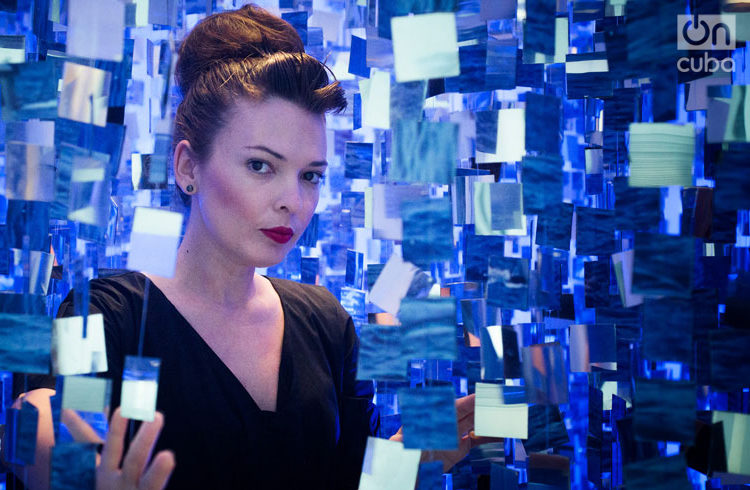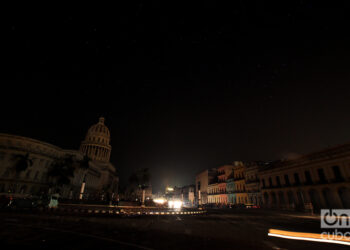When Mabel Poblet was barely a child and walked through the streets of her native Cienfuegos, she dreamed about being a ballerina, but she lacked the necessary physical aptitudes: her mother, an architect, and her father, a renowned children’s theater company director, encouraged her to find herself. She started weighing her options in a school in the locality which did not give courses on engraving, the specialty she was interested in. That’s why she arrived in Havana when she was just 16 years old and was able to enroll in San Alejandro, the prestigious arts academy from which she graduated in 2007. Definitively in the capital, Mabel discovered her “way of communicating” and her “life’s passion”: visual arts.
Considered one of the most outstanding emerging artists in the Cuban contemporary context, she forms part of the 2000 generation with an aesthetics that is her very own. Her themes have to do with the family, love, friendship, intercontinental relations: “everything that is part of life flows in my work,” she says in an exclusive interview for OnCuba.
———————-
The year 2017 was one of great creative intensity for Mabel Poblet and for the materialization of dreams: she participated in the Cuba Pavilion in the Venice Biennial, “something I always yearned for and I feel greatly honored to have been chosen. I took to Venice an installation titled Escala de valores [Scale of Values]. It was truly impressive.”
With more than 50 personal and collective exhibitions in the United States, Portugal, Russia, South Korea, United Kingdom, Colombia, Ecuador and Spain, among other countries, Poblet recognizes that having studied in San Alejandro (2007) and having graduated from the Higher Institute of Art (2012), gave her the necessary tools to break away from the academy and open her own creative path. She affirms that the fact that the teachers are, at the same time, independent artists favors the dialogue and the expansion of views, while she recognizes her admiration for the work of Sandra Ramos and also recalls William Pérez, who involved her “in kinetic art.”
Another of the fundamental and decisive influences for the young artist was exchanging experiences with Julio le Parc in his workshop in Paris: “being close to the maestro gave my life a radical turn because getting to know a person with so much wisdom, so sweet, with so much love and with so much passion for his work, made me feel fortunate about my own work, about the career I chose and, above all, to realize how much can reach the entire world from a small workshop. That certainty is overwhelming.” And she immediately recognizes that such an influence can be perceived in the series Patria (Homeland) in which she plays with movement, light, kinetics and, although they are static works, they can be catalogued as optic kinetic art.
Although Mabel Poblet doesn’t make a pure engraving, she does use it for work. It was the specialty that opened for her a field of expression for everything carried out until now: “I was interested in engraving, not to make multiple works but rather to make unique works based on the multiplicity of one same element; that is why there is a series of small fragments in most of my works which make up a greater image. I believe that way of doing comes from my formation as an engraver.”
The self-referential was evident in the beginnings, especially in her first series titled Lugar de origen (Place of Origin) based on photos of her family and of spots in Cienfuegos. Subsequently, in Abacos (Abacuses) the creator focuses on memory and on how we create a host of information throughout life: “I started getting to know more persons and stumbling upon social and political events that started affecting my daily life. All those experiences start settling and form part of creation; that is why I believe I have distanced myself a bit from self- referentiality, to speak of more global themes based on human interrelations.”
The human body has also been a support, a territory explored by Mabel based on the criterion that all human beings have common experiences, even if they have different lives: “we all see someone born, someone die; we move from a city, return to it and leave, we meet someone, we say goodbye, we meet again. In my work – after I left behind the self-referential – I started working with my own body, but to speak of other persons’ experiences. One of those examples is the work Simplemente bella [Simply Beautiful] in which I collaborated with a group of women inmates in the prisons of Holguín, in eastern Cuba. Until now Simplemente bella and Ana are two decisive pieces in my career.”
Mabel Poblet’s work is a constant, contemporary dialogue that is not indulgent at all with Cuban reality and also with matters of a planetary character, for example migrations. Her installations and sculptural objects are backed, first, on the idea and later on the technology. For example the work Marea alta (High Tide) – which forms part of the series Patria – “is focused on Cuba’s most recent history and how from abroad everything looks beautiful, but the journey crossing the sea can be very dangerous. That’s why the piece is made based on many fragments, of mirrors that allude to what you can encounter on the way that is beyond your expectations,” she affirms.
Although she confesses that her dream work is “achieving the nothing, the ephemeral, what you see and don’t see,” she still hasn’t reached that point, but she is convinced that it is “very complicated to get to the simplicity of the nothing.”
On the other hand, the color red frequently appears in her work because, for her, “it is a symbol of the forbidden and the wished for; it is in our blood – which is a vital liquid -, but at the same time it is found in the traffic, in the economy – which can allude to danger, to the stop signal; it is the color of love and of passion and therefore very temperamental.”
LOCALIZATION:
Mabel Poblet Pujol (Cienfuegos, 1986)
Studio-Workshop Address: Calle 11, no. 256, entre J e I, El Vedado, Havana, Cuba
Email: studiosmabelpoblet@gmail.com and mabelpoblet@cubarte.cult.cu










